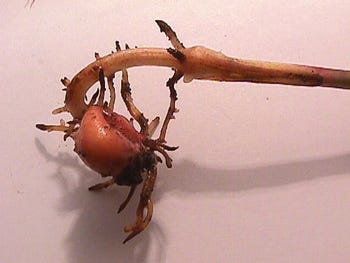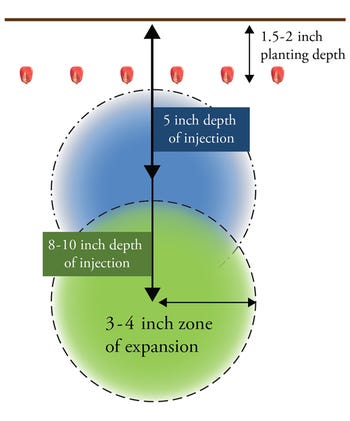May 17, 2019

Spring 2019 will not go on record as one that “worked just like I planned.” In my 30-plus years in southwest Iowa, I’ve never seen a majority of the crop get fertilized, sprayed and planted so fast. Several weather challenges prevented farmers from using Plan A this year.
We have a wide range of planting dates across Iowa for 2019. We still have acres that are not planted due to flooding issues this spring. When we look back on spring 2019, we may still be asking ourselves how we got all that work done in such a short window. Farming is a risk-and-reward business, and fertilizer and herbicide applications pushed that window and caused us to make higher risk decisions.
With an estimate of only 15% of the fall-applied nitrogen applications completed last fall, that set us up for large volumes of nitrogen to be applied this spring. With the narrow window due to the late spring rains and cold temperatures, planters followed anhydrous applications in some cases the same day. This caused some root burn on seedling corn plants.
Planting too soon after N application
For most farmers, Plan A was to apply anhydrous ammonia in the fall. Every farmer has a backup plan, so Plan B was to get out early and apply the N this spring in early April. With early April came more wet, cold weather, and massive flooding in the western and eastern portions of the state.
Moving on to Plan C — yes, there were fertilizer shortages across the Corn Belt due to logistical challenges and spot shortages of product. Now for Plan D, which is to apply fertilizer and plant. With Mother Nature only allowing short windows of opportunities, farmers and ag suppliers took calculated risks and got the job done.
 CLASSIC SYMPTOMS: Here is a close-up of a corn seedling injured by accessing the zone where anhydrous ammonia was injected.
CLASSIC SYMPTOMS: Here is a close-up of a corn seedling injured by accessing the zone where anhydrous ammonia was injected.

We need to understand the process of how ammonia can damage seedlings and look back at the choices we needed to make at application. Ammonia damage in most cases can be highly variable due to several application factors. When we experience ammonia burn on germinating corn seedlings we need to think about the process that occurs after ammonia is injected into the soil.
Going deep with anhydrous
After injection, physical and chemical reactions take place in the soil, as the ammonium ions are looking to attach to the cations in the soil. This is influenced by soil type, moisture level and depth of injection. The largest area of retention is in the first 1 to 2 inches from the point of injection out to about 3 to 4 inches maximum in most soils in Iowa.
University studies have determined anhydrous injected 4 inches deep can cause severe injury. But anhydrous ammonia injected 7 to 10 inches deep caused little injury, even when corn was planted the same day. In the studies, injecting anhydrous ammonia 10 inches deep reduced injury even more than applying anhydrous at a shallower depth and waiting 10 days to plant.
While most farmers this spring experienced moist soil conditions at application, we can still have issues with corn seedling injury if soil moisture was high enough that we did not get proper penetration of the injection knife, sidewall smearing occurred, and the ammonia moved up the knife track. Also, be aware that once anhydrous is injected into the soil, it immediately binds with water to form ammonium (NH4+). This form of nitrogen does not move with water.
Seedling response to ammonia
Seedling injury from anhydrous ammonia leads to uneven plant emergence and slow growth of young plants. Injured seedlings often have impaired roots, with limited ability to take in water. Keep in mind that anhydrous may expand farther than the typical 4-inch expansion zone from the point of injection. Thus, it can end up being dangerously close to the typical 2-inch planting depth for corn.
Farmers today have different types of anhydrous application equipment, from traditional deep placement application bars to low disturbance application equipment. Corn seedling response to ammonia burn is not specific to the application equipment. Rather, it depends on the relationship of the seed placement compared to the zone of anhydrous application.
 INJECTION DEPTH MATTERS: This graphic illustrates why depth matters when injecting anhydrous ammonia. The deeper it’s placed, the lower the odds that seeds or seedlings will be impacted.
INJECTION DEPTH MATTERS: This graphic illustrates why depth matters when injecting anhydrous ammonia. The deeper it’s placed, the lower the odds that seeds or seedlings will be impacted.

For detailed information comparing different styles of anhydrous application equipment, ISU research by John Sawyer, Daniel Barker and Mark Hanna looks at crop response to shallow placement of anhydrous ammonia in corn.
Several factors come to play after ammonia has been applied: soil type, moisture content, planting delay, ammonia depth, seeding depth and ammonia application rate. While timing is critical, risk management plays a role every day in farming.
Factors to consider in the future under better weather and soil conditions are to allow a waiting period before planting corn after anhydrous applications, deeper injection, and application row orientation compared to planting row direction. That is, apply the anhydrous in the direction you would normally plant, then run the planter between the knife rows when you plant corn.
There’s no magic number of days to delay planting corn after anhydrous application. The rule of thumb is five to seven days or longer, but it’s not a guarantee. Another way to minimize potential anhydrous injury to corn seedlings is to inject anhydrous ammonia 8 to 10 inches deep. In a University of Illinois study, injecting anhydrous 10 inches reduced injury even more than applying anhydrous at a shallower depth and waiting 10 days to plant.
I hope this coming fall the record pace in the fields is due to nice weather and better commodity prices.
Saeugling is an ISU Extension field agronomist covering southwest Iowa. Contact him at [email protected].
About the Author(s)
You May Also Like






